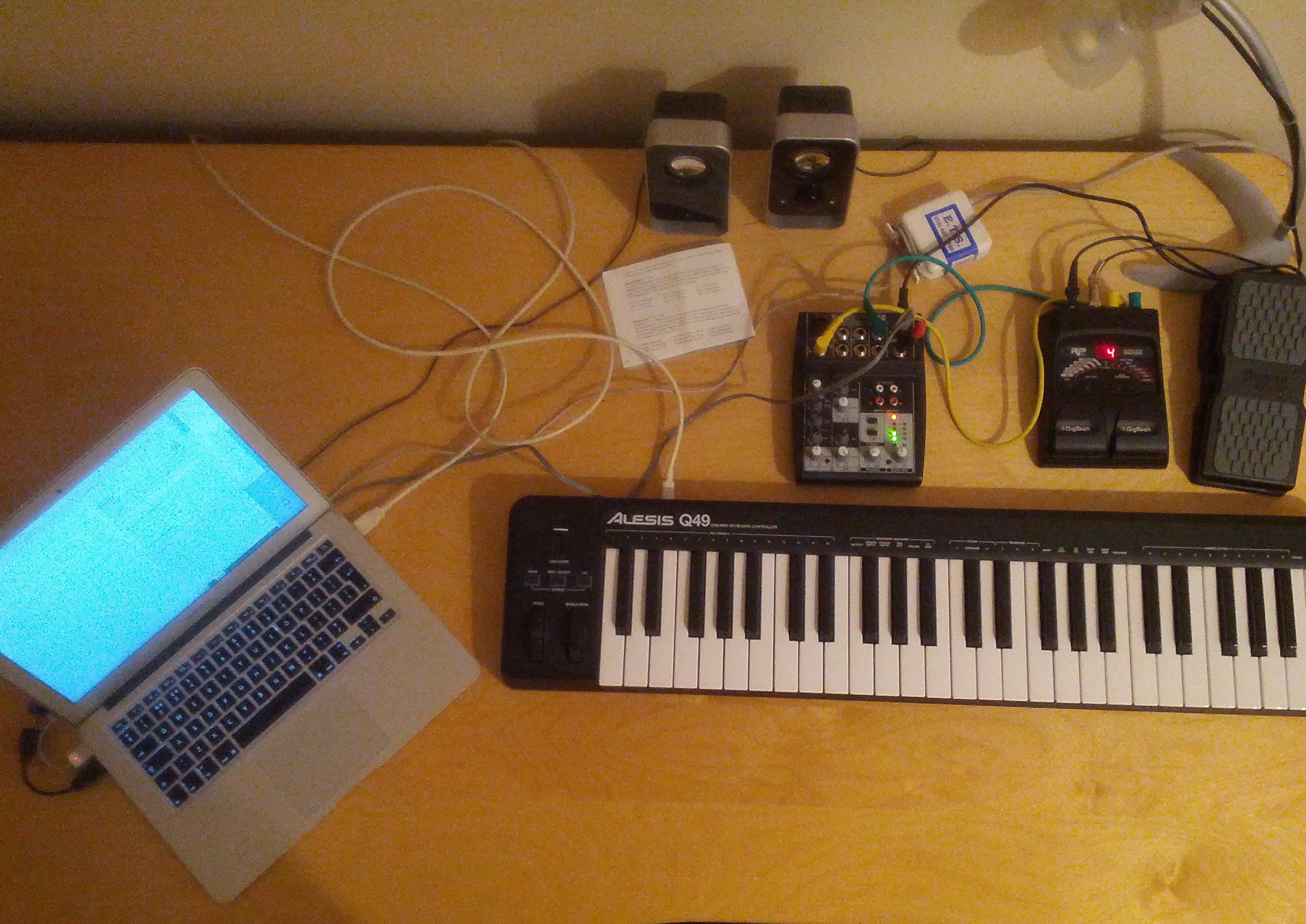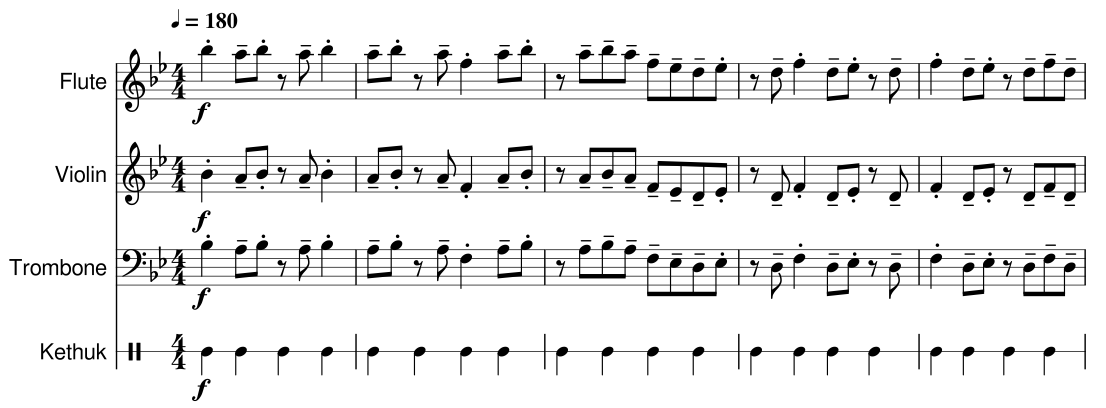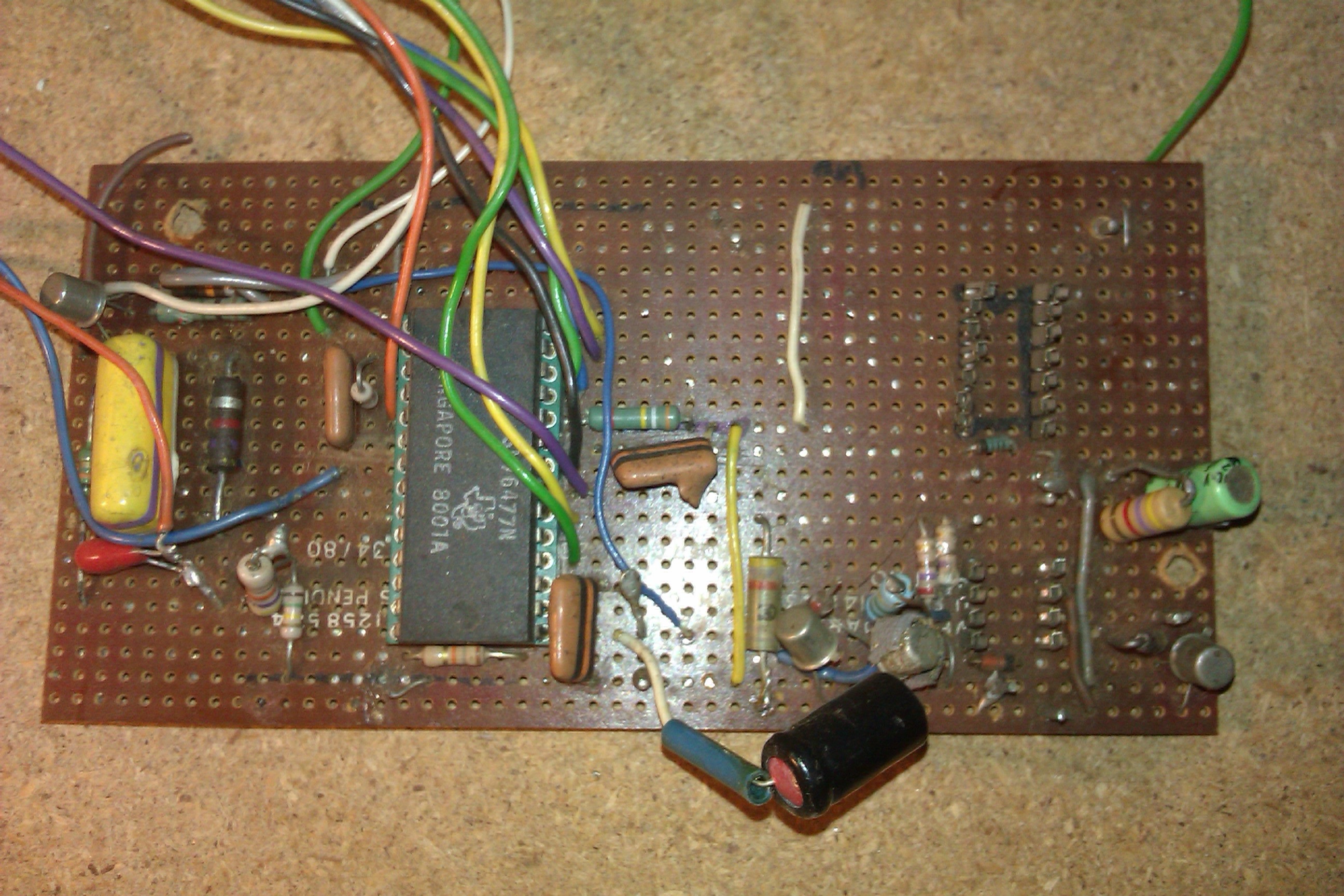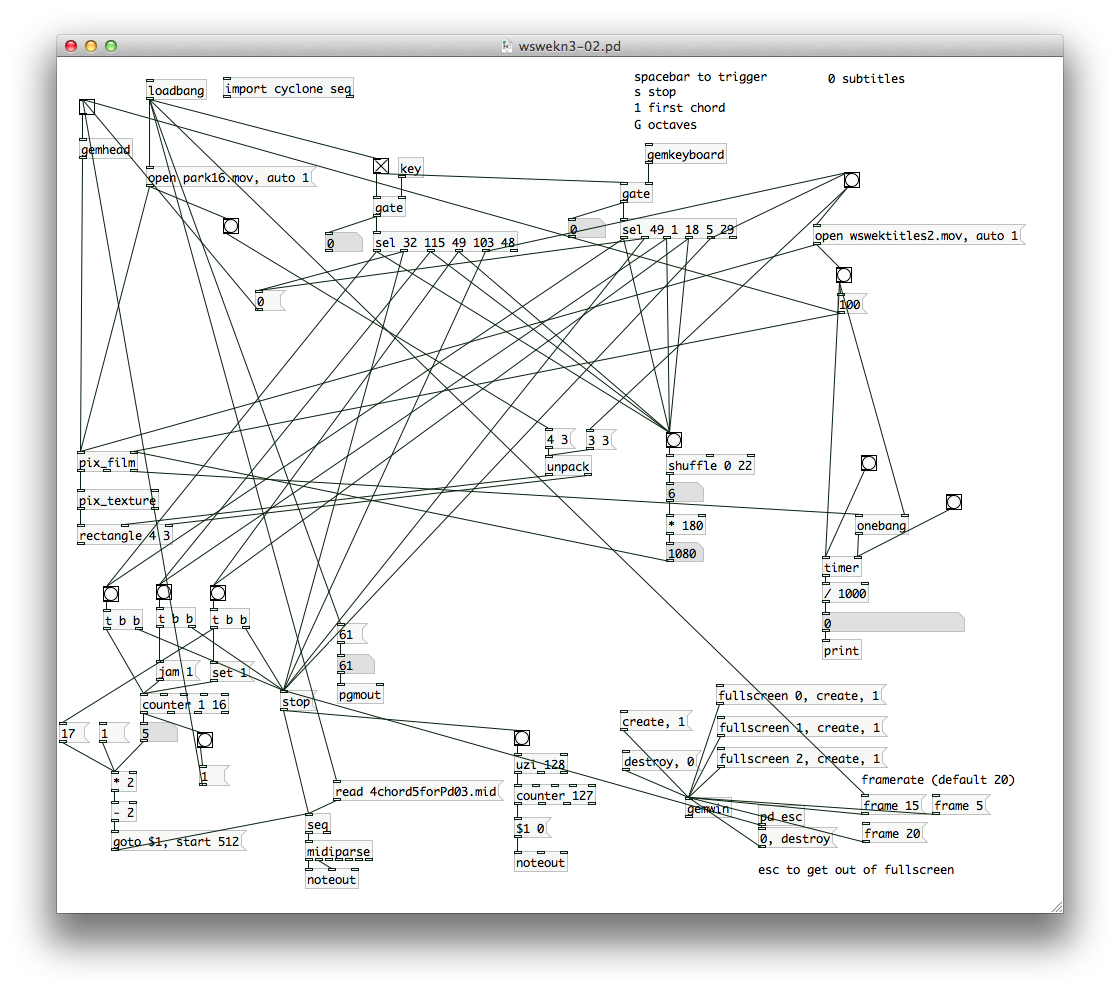The algorave was in a clubby sort of room above a pub. Code from each performer's laptop was projected on a black behind them, while some livecoded visuals in IBNIZ were projected on an adjacent wall. A good atmosphere, although I found the gig sometimes painfully loud, especially with those very forward and raw sounds which you sometimes get from coded synths.
From this point on, my memory is a little blurred. A very abstract and glitchy set from Norah Lorway: not sure what tool she was using as she did not have time to plug into the projector. Also Charlie Roberts playing his own web-based Gibber language, with a nice line in livecoding the ascii text. Oh, and… Mico Rex – bonkers! In a good way: cardboard boxes, SC code, and exuberant singing.
Overall, a very pleasant long weekend in the very pleasant seaside town of Brighton. The Sussex University campus was very comfortable, as was the wonderful Dutch bike I hired from Amsterdammers.
Final braindump, below an archive of all the #lcatb tweets (some of the attributions here probably wrong, collected this list in a rather hacky way…):
Great response - mod syths @yaxu suggests that we don't react against the digital but instead software, which is 'generally awful' #lcatb berrydm 12:18pm via Twitter for iPhone
Andrew Duff showing his own personal "Orac" and modular synths at Live Coding and the Body #lcatb http://pic.twitter.com/RTq06khkYC thormagnusson Jul 05, 2:06pm via iOS
Here @allthesixes666 presents a graph that should resonate with many computer musicians' experience #lcatb http://pic.twitter.com/qE3aFcqBYT Retweeted by _sshaw and 4 others thormagnusson 11:52am via iOS
#lcatb Afternoon kicking-off with @berrydm & Nick Rothwell coding as collaborative fist class discipline http://pic.twitter.com/DtGJ7tB68v Retweeted by musicSussex and 5 others thormagnusson 12:08pm via iOS
Live coding the modular synths #lcatb http://pic.twitter.com/msuYv3o5vr Retweeted by musicSussex and 3 others thormagnusson 12:08pm via iOS
@ad_tpim Does 'lowres' modular syth demo at #lcatb symposium @SussexUni http://instagram.com/p/qG3rrrKD16/ thormagnusson 11:52am via iOS
Andrew Duff's great modular synth setup at Live Coding and the Body seminar. Cool! #lcatb http://pic.twitter.com/5e7M3Bk7Wp pauwly 12:01pm via Twitter for Android
Andrew Duff @allthesixes666 blames his modular addiction on close friend @RussellHaswell #lcatb http://pic.twitter.com/e14heqdtKE thormagnusson 11:52am via iOS
#lcatb Pismo, very nice, I've already got one :) pauwly 11:43am via Twitter for Android
Great talk by David Ogborn d0kt0r0.net #Livecoding #acousmonium #spacialisation #emodiment #lcatb http://pic.twitter.com/CM9eLPhBFi tedthetrumpet 11:35am via Hootsuite
http://ow.ly/i/68GoK David Ogborn offering some leads to follow #lcatb renick 11:21am via Twitter for Android
@berrydm wish an AI were running traffic on the way to #lcatb today... Show Conversation pauwly 11:00am via Twitter for Android
Open questions about control through gesticulation and code in live performance #lcatb http://pic.twitter.com/LuQZVgmsL9 lukechurch 10:55am via TweetDeck
Watching Andrew Brown merge gestural control via an iPad and a text programming language at #lcatb, we should add this to #DynamoBIM soon. tedthetrumpet 10:51am via Hootsuite
#lcatb Andrew R Brown reflecting on the balance between textual and gestural control berrydm 10:44am via Twitter for iPhone
Day 2- Live Coding and the Body on a Sunday (!?!) with Andrew Brown (gestural controllers & code description) #lcatb http://pic.twitter.com/AuCgcdjeNC TanyaMGoncalves 10:43am via Twitter for Android
#LCATB - sad that today is my last day of confrences #untilnexttime http://pic.twitter.com/E4TsL7KpoY tedthetrumpet 9:28am via Hootsuite
Day 2 of Livecoding and the Body starts soon: great to be here, meeting interesting people, and learning stuff http://livecodenetwork.org/body/ #lcatb TanyaMGoncalves Jul 05, 3:47pm via Twitter for Android
@d0kt0r0 performing live #LCATB http://pic.twitter.com/qRegzVZdhh Retweeted by d0kt0r0 and 1 others yaxu 12:31am via Twitter Web Client
Super discussions at the live coding at the body symposium, check out the #LCATB hashtag. Retweeted by supersg559 yaxu 12:31am via Twitter Web Client
Soviet synthesizer bridged occultism and electronic music — will be of interest to #lcatb http://boingboing.net/2012/06/27/syn… thormagnusson Jul 05, 2:06pm via iOS
#lcatb Afternoon kicking-off with @berrydm & Nick Rothwell coding as collaborative fist class discipline http://pic.twitter.com/DtGJ7tB68v Retweeted by giovamusic and 5 others TanyaMGoncalves Jul 05, 5:10pm via Twitter for Android
@yaxu @yaxuprime Alex McLean #LCATB http:// pic.twitter.com/k99dG29Rcf shelly_knotts Jul 05, 5:10pm via Twitter Web Client
nice to have a few controversial comments - referring to live coding as a gendered practice is fairly problematic #lcatb tedthetrumpet Jul 05, 5:04pm via Hootsuite
#lcatb interesting discussion around livecoding compared with the work of Jackson Pollock cappelnord Jul 05, 4:58pm via Twitter Web Client
#lcatb people: Thanks for tweeting! kunstwissen Jul 05, 4:36pm via Twitter Web Client
Micorex ask: why should a live coder be on stage? after presenting some of their practice: hitting buttons, singing, dancing… moving #lcatb Retweeted by sicchio and 1 others danny_bright Jul 05, 4:28pm via Twitter for iPhone
Awesome - cardboard boxes full of wires and joysticks - surely the best controllers #lcatb http://pic.twitter.com/RbPS0HWbjm Retweeted by livecodenet kunstwissen Jul 05, 4:40pm via Twitter Web Client
@kunstwissen some responses:challenging context of performance, sharing experience, put emphasis on coding as a cultural practice #lcatb Retweeted by livecodenet kunstwissen Jul 05, 4:36pm via Twitter Web Client
@d0kt0r0 performs with a multi channel live coding demon which is //not evil #lcatb http://pic.twitter.com/ykZZ2mXne0 Retweeted by tedthetrumpet and 1 others kunstwissen Jul 05, 4:36pm via Twitter Web Client
A brilliant presentation by @cassieldotcom on code and choreography. #lcatb http://pic.twitter.com/b7gFQNJJN9 Retweeted by livecodenet and 6 others shelly_knotts Jul 05, 2:33pm via Twitter Web Client
next symposium: 'Live Coding and Socks'? ;) #lcatb Retweeted by livecodenet pauwly Jul 05, 3:00pm via Twitter for Android
We're flying now - forget Deleuze #lcatb Retweeted by livecodenet pauwly Jul 05, 2:39pm via Twitter for Android
Hester Reeve - Why might we choose to use the body live? The audience as witness and not consumer. #lcatb http://pic.twitter.com/J607tF57lE Retweeted by livecodenet and 1 others berrydm Jul 05, 3:46pm via Twitter for iPhone
Next Marije Baalman live coding a set #lcatb http://marijebaalman.eu http://pic.twitter.com/7bpQtKBNYk Retweeted by livecodenet TanyaMGoncalves Jul 05, 3:47pm via Twitter for Android
#lcatb David Ogborn performs - #guitar meets #SuperCollider #generative #code http://pic.twitter.com/HYZjf8YTCH Retweeted by livecodenet and 1 others danny_bright Jul 05, 4:15pm via Twitter for iPhone
Lots of interesting people, talks, presentations and performances so far at #lcatb @musicSussex sicchio Jul 05, 3:36pm via Twitter for iPhone
Performance #2 Marije Baalman http://marijebaalman.eu - making the code sweat! #lcatb http://pic.twitter.com/HJkM9EtNDO Retweeted by livecodenet and 1 others pauwly Jul 05, 4:09pm via Twitter for Android
@d0kt0r0 performs with a multi channel live coding demon which is //not evil #lcatb http://pic.twitter.com/ykZZ2mXne0 Retweeted by shelly_knotts and 1 others TanyaMGoncalves Jul 05, 3:47pm via Twitter for Android
@d0kt0r0 performing live #LCATB http://pic.twitter.com/qRegzVZdhh 2 retweets berrydm Jul 05, 3:46pm via Twitter for iPhone
David Ogborn playing guitar & live coding set - interesting use of live generated code #lcatb d0kt0r0.net http://pic.twitter.com/skVRCI1AcX sicchio Jul 05, 3:36pm via Twitter for iPhone
Trying to keep up with Live Coding and the Body tweets #lcatb 1 retweets tedthetrumpet Jul 05, 3:31pm via Hootsuite
#lcatb surrounded by all these coders, I should probably just *ask* someone why my Pbindef won't .play until I .stop it :) thormagnusson Jul 05, 2:06pm via iOS
Hester Reeve - Why might we choose to use the body live? The audience as witness and not consumer. #lcatb http://pic.twitter.com/J607tF57lE Retweeted by berrydm and 1 others pauwly Jul 05, 2:39pm via Twitter for Android
A brilliant presentation by @cassieldotcom on code and choreography. #lcatb http://pic.twitter.com/b7gFQNJJN9 Retweeted by readywriting and 6 others thormagnusson Jul 05, 2:06pm via iOS
A very provocative slide #lcatb http://pic.twitter.com/3C86R3jig6 Retweeted by livecodenet TanyaMGoncalves Jul 05, 1:49pm via Twitter for Android
Chats about #livecoding, I'm having a little too much fun right now. #LCATB http://pic.twitter.com/bvjctMorDH Retweeted by livecodenet pauwly Jul 05, 1:52pm via Twitter for Android
Here is the programme for the conference Live Coding and the Body 2014 #lcatb http://livecodenetwork.org/body/ Retweeted by goldsmif and 2 others tedthetrumpet Jul 05, 12:14pm via Hootsuite
#lcatb Renick Bell is trying to get the body *out* of performance (!?) Retweeted by livecodenet tedthetrumpet Jul 05, 12:14pm via Hootsuite
Now we have Renick Bell on pragmatic aesthetics ad live coding #lcatb http://renickbell.net/doku.php Retweeted by livecodenet berrydm Jul 05, 11:00am via iOS
Heideggerian phenomenology might give some useful notions for conceptualisation of live coding practice see http://beingintheworldmovie.com #lcatb Retweeted by livecodenet berrydm Jul 05, 11:54am via Twitter for iPhone
@livecodenet new discipline love coding? #lcatb Retweeted by livecodenet berrydm Jul 05, 11:48am via Twitter for iPhone
“@_TheTerminator_: @berrydm I am a cybernetic organism. Living tissue over a metal endoskeleton.” #lcatb Show Conversation kaoskorobase Jul 05, 11:45am via Twitter for iPad
I warned you.. @_TheTerminator_: @berrydm Skynet became self-aware at 2:14am Eastern time, August 29. #lcatb Show Conversation pauwly Jul 05, 11:38am via Twitter for Android
Now discussing livecoding blind & connecting machine directly to brain function..its a little after 11am ;D #lcatb http://pic.twitter.com/EH3lbJqNJb Retweeted by livecodenet pauwly Jul 05, 11:38am via Twitter for Android
So @thormagnusson outlines his scary brain control live coding ideas. Skynet will soon be here via ixi lang http://ixi-audio.net/ixilang/ #lcatb berrydm Jul 05, 11:24am via Twitter for iPhone
Live coding and contextual computing - interesting possibilities for new frameworks for creativity and sonic arts #lcatb livecodenet Jul 05, 11:22am via Twitter for Android
Marije Baalman providing analysis of love coding interaction loop. Wonders about live coding with eyes closed #lcatb http://pic.twitter.com/2AAPW6L6dl thormagnusson Jul 05, 11:01am via Twitter Web Client
A fantastic group of people have convened in the Creativity Zone at Sussex to discuss Live Coding and the Body #lcatb // @livecodenet Retweeted by livecodenet and 6 others berrydm Jul 05, 11:15am via Twitter for iPhone
How obduracy of the computer can be used to feedback electromagnetic waves into music & sound- Laptop Music (Reuss) - v. Cybernetic #lcatb TanyaMGoncalves Jul 05, 11:06am via Twitter for Android
#LCATB http://pic.twitter.com/VyS5fNmbHm berrydm Jul 05, 11:00am via iOS
Thanks for prompting hashtag @berrydm ;D Here we go, going to be great! #lcatb berrydm Jul 05, 11:03am via Twitter for iPhone
First speaker is Marije Baalman #lcatb http://marijebaalman.eu thormagnusson Jul 05, 11:01am via Twitter Web Client
"Michel [Waisvisz] was only interested in code if he could make it sweat" (Sally-Jane Norman) #lcatb tedthetrumpet Jul 05, 11:02am via Hootsuite
#lcatb so far I've learned how to pronounce 'NIME' and 'Gibber' tedthetrumpet Jul 05, 11:01am via Hootsuite
Sally Jane Norman introduces the first panel #lcatb http://pic.twitter.com/wlrKhgS6hz Retweeted by thormagnusson berrydm Jul 05, 10:58am via Twitter for iPhone
We have a hashtag for the Live Coding and the Body conference #lcatb @SussexUni Retweeted by thormagnusson berrydm Jul 05, 10:59am via Twitter for iPhone




